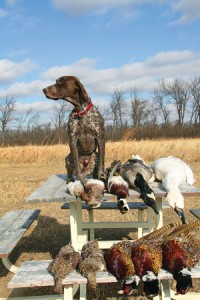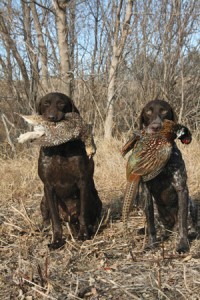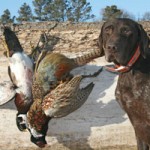I've seen German shorthaired pointers all over the world," was the answer Frank Fisk gave to this question: "In the million miles you have traveled with your job and your passion to hunt everywhere you go, what is the most popular pointing breed of gun dog you have found wherever you have been?"
As a construction engineer for 30 years, Fisk has been to every continent and shotgunned whatever upland gamebirds and waterfowl he finds there. "I've hunted with German shorthairs for grouse and ducks in South America, ringneck pheasants and Canada geese in Australia, woodcock in England and tundra swans in North Dakota, just to mention my most recent trips to a variety of places," Fisk says.
"Why German shorthairs?" Fisk has asked owners and hunting hosts when he has come across these gun dogs. "Lots of natural prey drive, point, and retrieve, a precocious breed that learns fast and hunts early in their lives, good house and kennel dogs, easy to train and maintain, and fairly easy to find from breeders," are the main responses to his question, Fisk says.
German shorthaired pointers have been particularly popular in the U.S. with gamebird hunters looking for a do-it-all versatile gun dog. There are approximately 10,000 German shorthairs annually registered with the American Kennel Club and the United Kennel Club. Likewise, shorthairs are the dominant breed in NAVHDA and have produced top scores in Natural Ability, Utility, and Versatile Champion testing for the past several decades.
German shorthaired pointers are also one of the main dog breeds in many kinds of field trials and a variety of hunting contests. And all across North America, shorthairs are the common pointing breed for the average gamebird hunter just about anywhere there are gamebirds to be hunted.
Short History
Despite the popularity and the 150-plus-year history of the German shorthaired pointer, the origins of this gun dog breed are sometimes vague and somewhat sketchy, according to Craig Koshyk, author of Pointing Dogs: The Continentals. Documents do support a fairly definite starting place and time for the beginnings of the breed, however.

In the mid-19th century breeders in Germany set out to deliberately create a gun dog so versatile that it would hunt all species of upland gamebirds and waterfowl as well as all kinds of small game. In addition, this all-around canine would also scent track big game such as wild boar and wounded deer and find and dispatch predators like fox and feral cats when necessary.
Genetic sources for this wonder dog included pointing breeds from Spain for sure and possibly from France and Italy, as well. The first efforts at creating the German shorthair, however, produced a mediocre specimen with an oversized body and short legs—a dog that looked like it was designed by a committee using spare parts.
The disappointing original German shorthair was improved early on by the multiple infusions of more foreign gun dogs, particularly the English pointer and possibly the English setter. Consequently, by the early 1870s the breed type was established in Germany, the National Deutsche Kurzhaar Klub was formed and an elaborate hunt testing program was implemented. Despite the disruptions caused by WWI, by the late 1930s the breed's genetics were well established so that the German shorthaired pointer had generally become the dog it is today in form and function.
American-Bred
The original German emphasis on wide ranging versatility, however, was changed when the German shorthair came to North America, where hunters were more focused on gamebirds and less interested in small game mammals and big game animals. Though a breed organization such as the Deutsch Kurzhaar Club of North America still adheres to the original German ideals with their dogs, most other German shorthair breeding and testing groups, such as the German Shorthair Club of America and NAVHDA, have dropped the Continental emphasis on blood tracking, fierceness in dispatching predators and tracking big game.
In AKC Hunt tests or the testing programs of NAVHDA and UKC, the German shorthair is mainly seen as an upland gamebird and waterfowl dog and is primarily judged on its ability to search for, find, point, track, and retrieve pheasants, quail, grouse, partridge, and other upland gamebirds and to fetch any ducks or geese that fall on land or water.
Ready Made
"I'm a little embarrassed to say that I don't know much about gun dog training, so I can't take much credit for the fact that my German shorthair, Sam, is such a good hunter," says Gordon Lander, an upland gamebird and waterfowl hunter from northwest Iowa. "When I got Sam as a 7-week-old puppy one year ago, all I did was teach some basic obedience at home in the yard, help develop his natural pointing and retrieving instincts, and introduce him to live birds with some pigeons.
"I let him learn how to swim by throwing a Dokken DeadFowl Trainer mallard and later a live duck into a shallow cattail slough. I also introduced him to gunfire by shooting around him a couple of times," Lander recollects.
"In early September, when Sam was a little over 7 months old, I took him on several mourning dove hunting trips. He found and retrieved more than four dozen dead or wounded birds that fell in tall grass, dense tree cover, and thick food plots. He also fetched a dozen doves from a 100-yard wide cattle pond. In late September, Sam retrieved several early season teal and some wood ducks from water in a creek where we jump shot them. And he even swam 200 yards to bring in a wing-tipped Canada goose I shot one day," Lander adds.
To prepare his German shorthair pup for pheasant season, Lander took Sam to a hunting preserve a couple times, where the young dog searched for, found, pointed and retrieved a half dozen roosters. "I also worked Sam on some wild pheasants on private property just for practice prior to the ringneck opener," Lander says. "So by the time the state season opened, Sam was making some productive pheasant hunts each time we went out."

By mid-November, however, Lander had some problems with his German shorthair. "Sam started to get on the trail of running roosters when we were after hunt-pressured birds. He would follow these pheasants way ahead of the guys with the shotguns then crowd the birds and bump them up way out of range," Lander recalls.
That is when Sam learned to respond to an e-collar with both stimulation and a beeper/locator. "I used a combination of a low power level nick associated with the sound of the beeper as a way of persuading him to slow down, stop, or come in when he got too far ahead of me," Lander says. "One beep meant stop and look at me, two beeps meant look for a signal to change directions, and a series of repeated beeps was the sign to come to me as fast as possible. By December, Sam's enthusiasm was under control," Lander concludes.
"Most German shorthaired pointers, unlike some other breeds of gun dogs, can hunt right out of the box," says Jim Keller, a professional dog trainer at Keller's Gun Dog Kennels near Lincoln, Neb. "By 'hunt right out of the box,' I mean that the average bird hunter with an average well-bred German shorthair can take a pup under a year old and, with a minimal amount of training and a maximum exposure to gamebirds, produce a competent and productive gun dog.
"This doesn't always happen with many other breeds because they don't have the early-blooming talent and innate hunting instincts produced by breeders with a broad genetic base from which to choose in creating gun dogs with strong natural hunting abilities," Keller feels.
Adaptable Canine
"In the past 33 years, we have had five German shorthairs and all of them have been combination indoor house dogs and outdoor kennel run dogs," says Lynette Fanning, who with her husband Frank lives close to Birmingham, Ala. "Though our dogs spend their nights sleeping on the floor at the foot of our bed, during the day, because Frank and I have to leave home for our work, the dogs stay in a chain link outside kennel," Fanning says.
This arrangement works out for two main reasons Fanning feels. "For one thing, we have chosen our puppies from lines that have clearly calm, easy-going and cooperative temperaments in addition to being high-powered hunters. Secondly, we exercise our dogs for 30 minutes every morning and 30 minutes every evening. And, I mean aerobic exercise that generates a high level of cardiovascular activity," Fanning says.

"We throw the standard tube-type plastic dummies in the backyard but in addition shoot the GoFrrr Ball. Because the GoFrrr ball bounces several times when it lands on a hard surface, most dogs just love it and will chase and retrieve it for more than half an hour," Fanning has found. "Because German shorthairs are such high energy canines, this combination of good temperament choice and regular exercise makes our dogs easily adaptable to life in the house and in the kennel outdoors."
Facts & Feelings
"Golly, what a beautiful dog," is a comment Amanda Warner often hears when she hunts her 6-year-old golden retriever, Hank, and her 4-year-old German shorthair, Max, at the beginning of the pheasant season in North Dakota.
The beautiful dog referred to, however, is almost always the golden, not the shorthair. Hank's golden coat is indeed aesthetically impressive as his silky hair glimmers in the sun and shimmers in the breeze. Max, on the other hand, has an ordinary short coat in a sort of a common liver with white ticking.
Warner doesn't deny that Hank is indeed a pretty dog. "But for practical applications, I prefer the short hair on Max most of the time," Warner says. "Take shedding, for example. When Hank sheds, the hair from a brushing and a floor sweeping can half fill a five-gallon bucket while the same shedding routine with Max will barely put a quarter-inch of hair into the bottom of a teacup," Warner says.
"Likewise, also on the practical side, finding and removing ticks and other insects in Max's short coat is easy while seeing and picking the bugs out of Hank's hair is just about impossible," Warner feels. "Same goes for locating and treating cuts, abrasions, and holes in Max's hide. Seeing any wound through the short hair is no big problem, while doing this search for wounds through Hank's long hair requires major effort and lots of time."
Another asset of short hair is apparent after Max and Hank have been swimming and come back to shore to shake off excess water. "When Max shakes, there is only a fine mist that quickly dissipates while Hank's long hair will produce a wet torrent that will soak his owner's clothes, face, and sunglasses," Warner testifies.
The coat on a German shorthair also has the advantage of drying fast after getting wet. "Swim any German shorthair across a pond to retrieve a late October jump shot mallard and the dog will be dry 20 minutes later. But do the same thing with a golden retriever on Friday morning and that dog will still be sopping wet on Saturday afternoon," says Warner with some slight exaggeration to make her point.
The German shorthair's short coat also has some major benefits in warm weather when the temperature gets into the 80s and the 90s. Pour on a little cool water and these shorthaired dogs can be hunted a lot longer than most long-haired breeds. Care must be exercised, however, for any dog during hot conditions in order to avoid any degree of heat stress.
Hank's long, dense coat does help him keep warm in cold and windy weather, Warner admits. "But on freezing, sub-zero, deep-snow days, I'll put a neoprene vest on Max and that will usually keep him warm and comfortable. In fact, even in cold water that vest will keep the air in his hair at around 80 degrees just by holding in body heat," Warner has seen.
Sandburs, cockleburs, and burdock are a real hazard in the long hair of Hank who sometimes gets so many of these sticky seeds in his long coat that a couple hours and great effort are necessary to remove them. "There is no bur problem, however, with Max's short hair because these burs never stick in the first place," says Warner.
"I love both my dogs equally," Warner concludes. "But on the subject of hair length, I certainly prefer the short hair on Max, my shorthair, when on a hunt for upland gamebirds or maintaining him around the house."

Born To Run
"Because field trial German shorthairs are programmed to run fast and far in competition where speed and distance are priorities, most field trial dogs aren't generally thought of as just plain hunting dogs that might stay in close for pheasants or ruffed grouse," says Dan Harrington from Lansing, Mich.
"My shorthairs have lots of field trial blood in them, but I can still use them on a pheasant or wood grouse hunt—if I use beeper-locator collars and a GPS unit to find them," Harrington notes. "Now North Dakota prairie grouse or Kansas quail out in the open we can usually hunt more effectively because we can see the dogs at a distance. The global positioning collar, however, is still useful, sometimes even essential," Harrington says.
"German shorthair breeders in general who want to add greater speed, wider range and greater stamina to their lines often come to our field trial genetics when they need these qualities," Harrington observes.
Exceptional Hunters
German shorthaired pointers from NAVHDA tested stock should have a built-in genetic propensity to be exceptional gamebird hunters. This is because of the organization's emphasis on judging all the versatile breeds for their natural ability and trained utility to hunt upland birds and all species of waterfowl, says Jim Rieser, DVM, an AKC and NAVHDA judge as well as a German shorthair breeder and hunter who lives in Franksville, Wis.
"Many shorthair breeders see NAVHDA as the place with the widest and deepest gene pool made up of dogs from a great variety of backgrounds that can include Deutsch Kurzhaars, field trial and hunt test dogs, and dogs proven as winners in competitive hunting contests," Rieser says.
With all the test scores and pedigrees available from NAVHDA, German shorthair breeders should be able to produce dogs that are specialists for hunting one type of gamebird yet generalists that can handle any kind of gamebird, Rieser adds.
Backyard Breeders
Dale Westly calls himself a "backyard breeder of German shorthaired pointers" and considers that designation a positive description of what he and groups of his hunting buddies do to produce a versatile gun dog that will find all the common upland gamebirds, plus retrieve every species of waterfowl.
"We base our breeding program on what we personally see our German shorthairs do in actual hunting experiences," Westly says. "Sure, impressive pedigrees and hunt testing scores are good to have, but what we know from personal experience about our dogs is the basis for our decisions about combining bloodlines."
Though Westly lives in Kansas, this retired veterinarian hunts all over North America and in Mexico with a half dozen of his friends, all of whom own two or more German shorthairs. "By the end of a typical season we have collectively spent several hundred days in the field and on the water, and therefore we can tell what dogs we will use for breeding. So far, that system seems to work just great," he adds.
Show Dog Circuit
For his 60th birthday, Ron Dillon's wife surprised him with a 7-week-old German shorthair puppy. "Dixie, I soon discovered, was out of a pair of show dogs. So I thought, oh no, this dog probably won't be a hunter," Dillon recollects.
He later took Dixie to a professional trainer who warned that a show dog might not make much of a gun dog. "After a month, the trainer called me to report on Dixie's progress. What a pleasant surprise. She pointed, she tracked, she retrieved, she loved water, she loved birds and she loved shotguns," Dillon recalls. "I'm going to hunt her on pheasants and ducks this coming season and I'm hoping for more pleasant surprises."
Although today's German shorthair is the most popular of the pointing breeds, these dogs have been popular throughout their history because they have been so adaptable to a variety of hunting purposes and because they mature early and display innate hunting abilities. Likewise, when chosen carefully and raised right, they are stable indoor house dogs and outside kennel dogs that are easy to maintain. And finally, German shorthairs are fairly easy to find from a wide variety of breeders anywhere in the world, further underscoring their universal adaptability.






